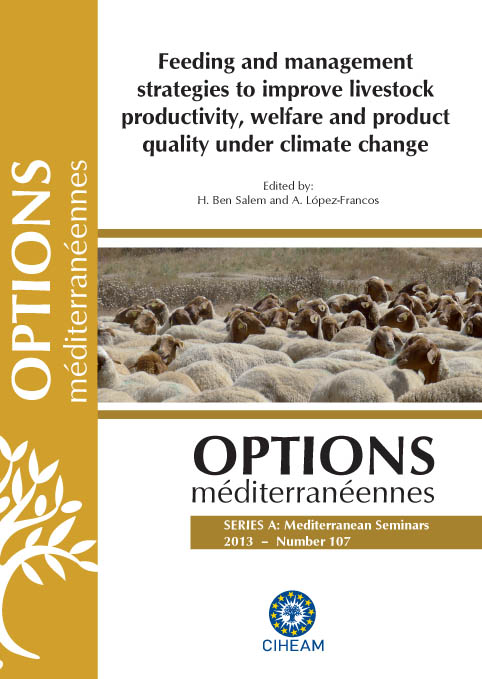| Article précédent | p. 213-218 | Article suivant |
Effects of replacing corn and soya beans with white sorghum and faba beans on milk quality of Sicilo Sarde dairy ewes in Tunisia
The effects of using white sorghum seeds and faba beans as feed resources were studied on milk performances in dairy Sicilo-Sarde ewes during the milking phase. Twenty ewes were divided into two homogeneous batches according to age, litter size, rank of lactation and live body weight. Ewes received 1.5 kg DM of oat hay /ewe/day supplemented with 500 g/ewe/day of a standard concentrate diet (group C) or a concentrate composed of local white sorghum, faba beans and a sheep vitamin and mineral supplement (group S). Milk quality was determined once a week on samples of bulk milk batch to measure the fat content by Lactoscan. The concentration of urea in milk was determined by the DMAB method. The extraction of lipids was determined following Folch et al. (1957) method; the fatty acid composition was determined by gas chromatography. The use of the experimental concentrate (white sorghum and faba beans) affected the protein, non fat solids and lactose contents (p<0.05). The average level of urea was 53.5±8.76 and 35.5 ±3.4 mg/dl for the C and S (p <0.05), respectively. The main fatty acids were palmitic acid (27.75±1.29% vs. 27.77±1.21% of total fatty acids for the S and C diets, respectively; p>0.05) and miristic acid (12.06±0.82% and 12.47±1.21% for CC and CS, respectively; p>0.05). The average of capric acid was comparable in both concentrates (7.17±1.17%) in the control group (C) and 7.38 ± 1.39% in the experimental group (S). The concentration of conjugated linoleic acid (CLA) was 0.48 ± 0.03 and 0.36 ± 0.09% for the for the C and S ewe groups, respectively (p>0.05).
L’effet de l’utilisation du sorgho blanc et de la féverole comme ressources alimentaires locales a été étudié sur les performances laitières de la brebis Sicilo-Sarde durant la phase de traite. Vingt brebis ont été divisées en deux groupes homogènes selon l’âge, la taille de la portée, le numéro de lactation et le poids vif. Les brebis ont reçu 1,5 kg MS/brebis/jour de foin d’avoine complémenté par 500 g/brebis/jour d’aliment concentré commercial (lot C), et 500 g/brebis/jour d’aliment concentré local à base de sorgho blanc, féverole et CMV ovins (lot S). La qualité du lait durant les semaines de contrôle a été déterminée par un Lactoscan Milk analysis. La concentration de l’urée du lait a été déterminée par la méthode DMAB. L’extraction des lipides du lait a été déterminée selon la méthode de Folch et al. (1957). Le remplacement du maïs et tourteau de soja par le sorgho blanc et la féverole a affecté l’extrait sec dégraissé et le lactose du lait (p<0,05). La moyenne de l’urée du lait était de 53,5 ± 8,76 pour le lot C et 35, 5 ± 3,4 mg/dl pour le lot S (p<0,05). La moyenne des acides gras était pour l’acide palmitique C16 (27,75 ± 1,29% vs. 27,77 ± 1,21% des acides gras totaux respectivement pour les lots S et C) et pour l’acide myristique C14 (12,06 ± 0,82 % et 12,47 ± 1,21% respectivement pour C et S). La moyenne de l’acide caprique C10 était comparable (p>0,05) pour les deux aliments concentrés: 7,17 ± 1,17 pour le lot témoin (C) et 7,38 ± 1,39 % pour le lot expérimental (S). La concentration de l’acide linoléique conjugué (CLA) était 0,48 ± 0,03 et 0,36 ± 0,09% respectivement pour les lots C et S. Les acides gras totaux étaient comparables (p>0,05) pour le lait des brebis des deux groupes.
- [ Afficher ]
- [ Télécharger ]
- [ Exporter la citation ]
Vous pouvez télécharger la citation au format :
- [ Imprimer ]
-
Mots-clés
ACIDE GRAS, LAIT, MOUTON, QUALITE, UREECiter cet article
Selmi H., Kamoun M., Tibaoui G., Ben Gara A., Rouissi H. Effects of replacing corn and soya beans with white sorghum and faba beans on milk quality of Sicilo Sarde dairy ewes in Tunisia. In : Ben Salem H. (ed.), López-Francos A. (ed.). Feeding and management strategies to improve livestock productivity, welfare and product quality under climate change. Zaragoza : CIHEAM / INRAT / OEP / IRESA / FAO, 2013. p. 213-218. (Options Méditerranéennes : Série A. Séminaires Méditerranéens; n. 107). 14. International Seminar of the Sub-Network on Nutrition of the FAO-CIHEAM Inter-Regional Cooperative Research and Development Network on Sheep and Goats, 2012/06/15-17, Hammamet (Tunisia). http://om.ciheam.org/om/pdf/a107/00007035.pdf



